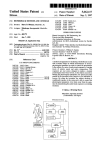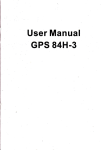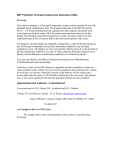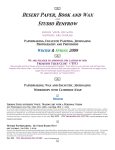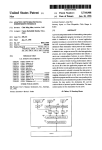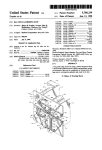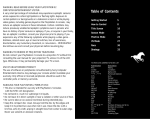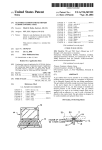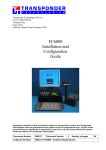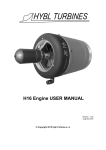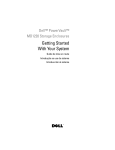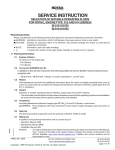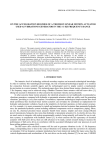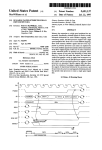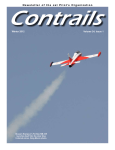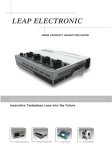Download For classifying mixtures of hydrocarbon fuels according to octane or
Transcript
USO05654497A United States Patent [19] [11] Patent Number: Ho?heins et al. [45] Date of Patent: [75] Inventors: Barbara S. Ho?heins, Knoxville; Robert J. Lauf, Oak Ridge, both of Tenn. [73] Assignee: Lockheed Martin Energy Systems, Inc. Jun. 3, 1996 [63] Continuation of Ser. No. 301,147, Sep. 6, 1994, abandoned, which is a continuation-in-part of Ser. No. 845,127, Mar. 3, 1992, abandoned. Int. Cl.6 .......................... .. G01N 27/16; G08B 17/10 US. Cl. ......................... .. 73/23.2; 73/31.05; 364/498 Field of Search ................................ .. 73/23.31, 23.2. 73/23.41. 31.05; 395/21, 22, 24, 27; 364/498 U.S. PATENT DOCUMENTS 4,542,640 4,631,952 7/1984 Iwanaga et al. ..................... .. 73/31.05 9/1985 Cliiford 1989. J. W. Gardner, “Detection of Vapours and Odours from a . .. .. . ... . . . . . . . . .. 12/1986 Donaghey ......... .. Experimental Report, Intel Corp., Santa Clara, CA, May 1990. MD1220 Neural Bit Slice, Data Sheet, Micro Devices Corp., Lake Mary, FL, Mar. 1990. ANSim User’s Manual, Chapters 1, 3 (no date). [57] ABSTRACT 73/23 73/25.03 4,638,443 4,670,405 1/1987 Kaneyasu et al. 6/1987 Stetter et al. 4,818,348 4/1989 Stetter ........... .. 4,907,441 3/1990 Shurmer . . . . . . . . . . . .. 73/31.05 5,106,563 4/1992 Zaromb . . . . . .. 73/23.4l 5,209,275 5/1993 Akibu et al. ....................... .. 73/23.2 X . . . ... . 1991. “Determination of Fuel Properties,” Research Disclosure, pp. 571-572, 1991. 80170W Electronically Trainable Analog Neural network, Primary Examiner—Michael Brock Attorney, Agent, or Firm-W. Mark Bielawski; James M. Spicer; Harold W. Adams References Cited 4,457,161 136-139, 1985. B. S. Hoffheins, Masters Thesis, University of Tennessee, tem,” Paper No. 253, Pittsburgh Conference, Chicago, Mar. Related US Application Data [56] Integrated Sensor,” Proc. of Transducers ’85, 1985 Intl. Con. on Solid State Sensors & Actuators, Philadelphia, PA, Multisensor Array Using Pattern Recognition Part I. Prin cipal Component and Cluster Analysis,” Sensors and Actua tors B, vol. 4, 109-115, 1991. P. N. Bartlett, ‘The Design of an Arti?cial Olfactory Sys [21] Appl. No.: 655,664 [51] [52] [58] Aug. 5, 1997 A. Ikegami & M.Kaneyasu, “Olfactory Detection Using [54] MOTOR VEHICLE FUEL ANALYZER [22] Filed: 5,654,497 73/31.05 73/23.2 . 73/23.2 X OTHER PUBLICATIONS A gas detecting system for classifying the type of liquid fuel in a container or tank. The system includes a plurality of semiconductor gas sensors, each of which diifers from the other in its response to various organic vapors. The system includes a means of processing the responses of the plurality of sensors such that the responses to any particular organic substance or mixture is su?iciently distinctive to constitute a recognizable “signature”. The signature of known sub stances are collected and divided into two classes based on S. Zaromb and J. R. Stetter, Sensors and Actuators, 6 (1984) 225-243. Gardner, J. W., et al“Application of Arti?cial Neural Net works in an Electronic Nose,” Meas. Sci. TechnoL, 1 (1990) 446—45 1. Lauf et al., Fuel, 1991, vol. 70, Aug., pp. 935-940. Gardner, I. S., et al (eds.) Techniques and Mechanisms in the characteristic of interest, such as its suitability for a particular use. Gas Sensing, Chapter 14, “Pattern Recognition in Gas Sensing,” Adam Hilger, Bristol, 1991, pp. 347-380. 29 Claims, 14 Drawing Sheets some other known characteristic of the substances. A pattern recognition system classi?es the signature of an unknown substance with reference to the two user-de?ned classes, thereby classifying the unknown substance with regard to DATA ACQUISITION PROGRAM 36 32 A/D CONVERTOR 12 BIT PATTERN CONVERSION PROGRAM / 1 / 13 NEURAL 34 DISPLAY OF CLASSIFI CATION 37 US. Patent Aug. 5, 1997 Sheet 2 of 14 5,654,497 CONFIGURE SENSOR ARRAY > DEVELOP LIBRARY OF SIGNATURES FORM TRAINING PATTERNS I TRAIN THE NEURAL NETWORK ANALYZE UNKNOWN SAMPLE Figure 2 r43 US. Patent Aug. 5, 1997 Sheet 3 of 14 5,654,497 2000 II] AVIATION GASOLINE 100 OCTANE E JETA+DE|CER 0.1 vowo m JETA 1500 -- (RuEanSrPbiONtsEar)y E5 0 O - l I 500 — Q II‘ II ’ 12345678910 SENSOR Figure 3 — US. Patent Aug. 5, 1997 Sheet 4 of 14 2000 [:I IE3 E 1 500 JP-4 JP-5 JP-7 JP-7 (thermally stable) uRaErnSbPiOtNsaEr)y V 1000 500 12345678910 SENSOR Figure 4 5,654,497 US. Patent JET A Aug. 5, 1997 Sheet 5 of 14 JET A + DEICER GASOLINE GRADE 100LL 5,654,497 JP-4 12345678910 12345678910 12345678910 12345678910 SENSOR SENSOR SENSOR SENSOR J P-5 JP-7 12345678910 12345678910 12345678910 SENSOR SENSOR SENSOR Figure 5 US. Patent Aug. 5, 1997 Sheet 6 of 14 4000 SHELL Ruzooo 3000 — AEmBEQ:m v 2000 — mwzO 1 000 1. 2345678910 SENSOR Figure 6 5,654,497 US. Patent Aug. 5, 1997 Sheet 7 0f 14 5,654,497 4000 SHELL SR2000 I 3000 Ru(EanSrPbiONtsEar)y l\) O O O - ' | 1000 ' Figure 7 ' * US. Patent Aug. 5, 1997 Sheet 8 of 14 2000 SHELL SU2000 1500 ‘— ma2wzgoe%ms 1000 — 500 12345678910 SENSOR Figure 8 5,654,497 US. Patent Aug. 5, 1997 Sheet 9 of 14 5,654,497 4000 REGULAR UNLEADED GASOLINE 10% ETHANOL 3000 —- R(uEaSnrPbiONtsEar)y l\) OOO —— | 1000 ‘— _ Figure 9 US. Patent Aug. 5, 1997 Sheet 10 of 14 5,654,497 JET A + GASOLINE JET A DEICER GRADE 1OOLL JP-4 1610 SENSOR 1610 SENSOR 1610 SENSOR 1610 SENSOR JP-5 JP-7 JP- (T8) 1 610 SENSOR 1 610 SENSOR 1 610 SENSOR Figure 10 U.S. Patent 50\ Aug. 5, 1997 Sheet 11 0f 14 5,654,497 /@ My“ i v v Array Data Conversion Pattern Classifier No-Go Go Figure 11 -- 53 US. Patent Aug. 5, 1997 Sheet 12 of 14 5,654,497 2:5NP US. Patent Aug. 5, 1997 Sheet 13 of 14 5,654,497 70 74 7;: ____::_' 75 76 ,._._____._.__._....._._.___._______._.______________________ Figure 13 US. Patent _ Aug. 5, 1997 Sheet 14 of 14 _ Array Data SW'tCh' Conversion select for fuel A _J'— type ‘_B__ + Pattern (3 ' 5,654,497 Classi?er l ' No-Go l Go Sensor Array l® [GD 6) Array Data Conversion . ' . . Pattern Pattern Pattern Classifier Classifier Classifier llllll Go No-Go Go No-Go Go No-Go Figure 14 . _ . . 5,654,497 1 2 MOTOR VEHICLE FUEL ANALYZER simpli?ed through the use of semiconductor gas sensors together with pattern recognition and/or neural networks (B. S. Ho?heins, Master’s Thesis, University of Tennessee, This application is a continuation of application Ser. No. 08/301,147, ?led Sep. 6, 1994, now abandoned, which is a 1989). Ho?heins reported results of using a nine sensor array with a neural network to analyze the patterns of a six continuation in part of application Ser. No. 07/845,127, ?led Mar. 3, 1992, now abandoned. item group comprising isopropanol, methanol, ethanol, This invention was made with Government support heptane, hexane, and hexane-2% ethanol. In addition, an ' under contract no. DE-AC05-84OR21400 awarded by the integrated sensor array was used to obtain patterns of one U.S. Department of Energy. The research was funded through the O?ice of Arms Control (DP-5). Systems and Technology Division. The Government has certain rights in either methanol or ethanol. added to it Although slight gasoline sample and samples of the same gasoline with diiferences were noted in the patterns, no attempt was made this invention. BACKGROUND OF THE INVENTION 1. Field of the Invention 15 The invention relates generally to systems for identifying to classify the gasoline samples with a neural network. In 1991, Gardner and Bartlett in separate papers reported results similar to Hoffheins (J. W. Gardner, “Detection of Vapours and Odours from a Multisensor Array Using Pattern Recognition Part 1. Principal Component and Cluster liquid fuels. Analysis”, Sensors and Actuators B, V014, 109-115, 1991), (P. N. Bartlett, ‘The Design of an Arti?cial Olfactory System, ” Paper no. 253, Pittsburgh Conference, Chicago, March 1991). There is an increasing demand for small, rugged and portable instruments to identify organic substances in the Also in 1991, anonymous authors reported applying a neural network to the spectroscopic analysis of infrared data organic liquids, and more particularly to a ?eld-utilizable analytical instrument using a semiconductor gas sensor array and neural network processor to identify and characterize (“Determination of Fuel Properties”, Research Disclosure, ?eld. In particular, there is need for a ?eld instrument capable of rapid, on-site analysis and identi?cation of avia tion and automotive fuels. Some of the applications for such 25 the correct grade of fuel, checking gasoline at the point of sale for alcohol and/or octane number (ON), and verifying that fuel storage facilities contain the proper grades of fuel. combustion engine, and requires sophisticated equipment knock characteristics. OBJECI‘ S It is a principal object of this invention to provide a system for rapid and convenient analysis of complex gas 35 mixtures that are chemically similar. Another principal object of this invention is to provide a selective analysis system for fuels, particularly those used in and hours of setup time. Laboratory-grade instruments nor mally used in conjunction with octane number measure ments may involve infrared spectrum analysis, multivariate aviation and automobiles. A third principal object of this invention is to provide a selective analysis system for classifying the signatures of a regression analysis, ?ame reactions, mass spectrometers, gas plurality of fuels using a fewer number of sensors than fuels. It is also an object of this invention to provide a rapid chromatographs, microprocessot-controlled octane analyzers, and others. The laboratory instruments often have the capability to analyze a large number of compounds at analysis system for classifying fuels according to octane low concentrations, but generally are too cumbersome for ?eld use and often require time-consuming sample prepa attempt to produce an instrument designed speci?cally for determination of octane number by indirect means, that is, without actually burning the fuel in an engine and observing an instrument are ensuring that an aircraft is refueled with All of these needs as well as other safety-related applications would be met by an instrument capable of quick determi nations of fuel type and octane number in the ?eld. The usual test for octane number is the rigorous CFR test which is based on running the fuel through an internal pp. 571-572, 1991). This last reference appears to be the ?rst 45 ration as well. 2. Description of the Prior Art The ?rst examples of prior art involve gas sensor arrays number or suitability for a particular vehicle, engine, or class of vehicles. Another object of the invention is to provide a fuel inspection method that is more convenient than the CFR engine method. coupled with pattern recognition approaches to identify Yet another object of this invention is to provide a fuel unknown gas samples. The ?rst of these (P. K. Clifford, “Selective Gas Detection and Measurement System”, U.S. Pat. No. 4,542,640, Issued Sep. 24, 1985), is a chemometric approach that relies on the solution of linear equations. Clifford’s method is unsuitable when dealing with liquid analysis system that eliminates tedious calibration processes fuels, which may have tens or hundreds of individual 55 and extensive numerical calculations. A further object of the invention is to provide an analysis system for complex organic substances that is not limited to simple, essentially pure compounds. the number of sensors be greater than or equal to the number SUIVIMARY OF THE INVENTION The rapid fuel analysis instrument works on the principle of unknown gases. The second example (A. lkegarni and M. that an array of gas sensors will react to fuel vapors in such Kaneyasu, “Olfactory Detection Using Integrated Sensor”, Proc. of Transducers ’85, 1985 Iutl. Conf. on Solid State a way that each fuel has a distinctive signature. The signa tures arerthen “learned” by a neural network. When an Sensors and Actuators, Philadelphia, Pa., 136-139, 1985), unknown sample is tested, the neural network examines the organic constituents. Clifford’s approach also requires that uses a microcomputer to mathematically calculate the simi signature and determines the closest match to the known larities in patterns of certain essentially pure substances that patterns. The sensor head contains ten commercial metal are not necessarily chemically similar. oxide gas sensors. The measured parameter is the resistance Recent work by B. S. Holfheins at the Oak Ridge National 65 of the metal oxide, which decreases in the presence of organic or reducing vapors. Nine of the sensors are nomi Laboratory showed that the problem of qualitative gas analysis of a few essentially pure substances can be greatly nally identical, except their heaters are powered at different 5,654,497 3 4 levels. This causes the sensors to react di?°erently to the are exposed to the vapors from the fuel 15. DC. power is supplied to the heater of each sensor 1-10 through indi vidual voltage divider networks 20-29 connected to a DC. power supply 30. Each heater network 20—-29 can be indi vapor sample present in the sensor chamber. The tenth sensor has a different combination of metal oxide and catalyst; consequently, its characteristic response can be quite different from the other sensors. The signature for a sample comprises the resistance readings taken from all ten vidually adjusted. a useful feature for tuning each sensor’s sensitivity for a particular problem set. Sensor outputs are D.C. biased (31) to conform to the input requirements of a sensors simultaneously. Signatures from the sensor array are multiple channel analog-to-digital (A/D) data acquisition scaled by an analog-to-digital (A/D) converter and trans formed into binary bit patterns, one for each sample gas. board 32 in a personal digital computer 33. In the computer 33, a cormnercial neural network simu Each pattern consists of a coded matrix. which is an appro 10 lation program 34 called ANSirnTM was used for classi?ca priate size for the problem at hand. A pattern size used was tion of the fuel signatures (ANSimTM, Science Applications International Corp., San Diego, Calif., 1987). In addition to 1X16 for each sensor, or 10X 16 for the ten sensors. A smaller pattern size can be used if fewer sensors are needed to the commercial neural network processor 34, two other computer programs are used in the invention. A bit pattern conversion program 35. written in the C language. is used to store and transform data from the A/D convertor 32 to bit patterns for use by the neural network 34. A second com puter program 36, written in GW Basic. facilitates the data acquisition process in the computer 33. Copies of the two programs are included in the Appendix hereto. determine the identity of substances in a particular applica tion. Alternatively. the size can be larger to increase the power of resolving the di?’erent signatures. A collection of these bit patterns from each of the possible substances in a problem set, called training vectors. is used to train the neural network. A neural network simulation program called ANSimTM, developed by Science Applications International 20 Among the several neural network paradigms available in the ANSimTM system, three autocorrelation paradigms (Hop?eld, Hamming and Boltzmann) were chosen because they retrieve patterns most like the input pattern presented to them. The operation of these networks also most closely ?ts 25 the operation of the gas sensor array detector; that is, the stored patterns would be the possible choices to which the Corporation. San Diego, was used. Once the neural network “learns” the training vector set. it can identify patterns from unknown samples. Collecting the signature of an unknown sample takes about ?ve minutes; identi?cation of the sig nature is virtually instantaneous. Samples require no special preparation. input pattern would be compared. Generally, the Hamming and Boltzmann networks represent improvements over the BRIEF DESCRIPTION OF THE DRAWINGS operation of the Hop?eld network and they have better FIG. 1 is a block diagram showing an embodiment of the FIG. 2 is a ?owchart of the method of this invention; success with the identi?cation problem. The ?nal element of the invention is a display means 37 for presenting the results of the classi?cation to the user. The ANSimTM program FIG. 3 is a graph illustrating the signatures of three civil provides side-by-side graphical displays of the sample pat present invention; aviation fuels; FIG. 4 is a graph illustrating the signatures of four military aviation fuels; 35 FIG. 5 is a graph illustrating the bit patterns of the seven aviation fuels of FIGS. 3 and 4. FIG. 6 is a graph illustrating the signature of an 87 ON motor fuel; FIG. 7 is a graph illustrating the signature of an 89 ON motor fuel; FIG. 8 is a graph illustrating the signature of a 92 ON motor fuel; FIG. 9 is a graph illustrating the signature of a 93 ON motor fuel with 10% ethanol; and FIG. 10 is a graph illustrating the bit patterns of the seven aviation fuels of FIGS. 3 and 4 using only three sensors; FIG. 11 is a block diagram of a simpli?ed embodiment of the present invention to be used for screening purposes; 40 tern being tested and the training vector or pattern it most closely resembles. The ANSirnTM program also provides a listing of names of all the samples the network has been trained on, and indicates which sample is the closest match to the sample under test. One sensor array used in tests to date comprised 10 discrete commercial Taguchi-type tin oxide sensors. A Taguchi-type metal oxide sensor exhibits a large change in resistance in the presence of gases to which it is sensitive. The resistance of the sensors used in this work were 45 50 observed to decrease by four to ?ve orders of magnitude when exposed to alcohol vapor, for example. Nine of the sensors (1-9) were the Figaro Engineering Model TGS 812, and were operated at power levels ranging from 100% (sensor 1) to 27% (sensor 9) of the manufacturer’s recom mended operating power (900 mW). Sensor 10. a Figaro Model TGS 824, was operated at 100% power. Table I gives the sensor power levels in detail. FIG. 12 illustrates the use of the present invention to inspect an unknown fuel supply; FIG. 13 shows one approach for incorporating the present invention directly into a vehicle; and FIG. 14 is a block diagram of a system wherein the pattern TABLE 1 Qperat1__n'g characteristics of the ten sensor array 55 Sensor 60 1 2 3 4 5 6 7 8 9 10 classes are selectable by the user. DETAILED DESCRIPTION OF THE INVENTION FIG. 1 illustrates a gas sensor array 11, data acquisition system 12, and data analysis system 13 for the classi?cation of volatile fuels according to the invention. In the ?gure. a chamber 14 contains the fuel 15 being tested. If desired, humid air may be passed through the chamber 14 in order to pick up fuel vapor and move it to chamber 16, which contains the gas sensor array 11. Sensing elements compris ing commercially-available semiconductor gas sensors 1-10 Model TGS TGS TGS TGS TGS TGS TGS TGS TGS TGS 812 812 812 812 812 812 812 812 812 824 % Rated Power 100 90 80 70 60 50 40 30 27 100 65 This is only one of many sensor arrangements. In addition to using nominally identical sensors operated at different 5,654,497 5 6 power levels (and therefore di?erent temperatures). different It is expected that several passes through steps 40—43 will be required, during which the sensor parameters are modi models of sensors can be used in the array. Many examples of sensor arrays composed of discrete sensors and miniature integrated sensor arrays on a single substrate have been ?ed until an optimized system is attained. It is realized that in general, the better the neural network is at classi?cation, described in the literature. Clitford, for example, described the more drift and variation it can tolerate from the sensor the value of homogeneous semiconductor gas sensors, sen sors that vary according to their composition, and sensors array patterns. In contrast, if the information from the sensor array is very reliable. and each signature is very distinctive, that vary according to their operating temperature, etc. The general rule is to ensure that each element (sensor) of the array will have ditferent response characteristics for the problem set of gases being examined. With such a variety of sensors and operating modes, the user can have wide control over the range of sensitivities of the different sensing then the neural network does not have to be as powerful. 10 is inherent in any neural network program, but which comprises analyzing the unknown sample against the library of signatures or training patterns as may be the case, and classifying it with respect to the storm signatures or training elements, thereby allowing the method to be optimized for a given analysis problem patterns. The method of operation of the invention will be more dearly described with reference to FIG. 2. FIG. 2 shows the process by which parameters for con?guring an instrument for a speci?c application are obtained The process consists of a series of steps, which are taken in order, and which may In all of the instrument applications cited above, one has access to a large concentration of the fuel vapors of interest, for instance, in the headspace of a storage tank. The use of require multiple passes through all or part of the steps in order to re?ne and optimize the system for a particular With the neural network “trained”, the only step remaining is that of analyzing an unknown sample (step 44), a step that 20 instrument application. The process begins with the selection of a sensor array (step 40). Sensors that are known to be sensitive to the problem substances should be chosen, as well as sensors that high concentrations of vapor makes the process somewhat faster and more reproducible. It is, in principle, possible to use the inventive technique with lower vapor concentrations provided that the neural network has been trained with signatures of each fuel at each expected concentration, and the signature of one fuel at one concentration does not resemble that of a diiferent fuel at another concentration. respond less strongly. Also, at this step, several sensors of 25 There is, in any case, a lower concentration limit below which classi?cation will become unreliable. one model might be included in the array, but each one operated at different temperatures as previously described, in order to study the range of possible responses. At this initial step 40, one should not be concerned with limiting the size of the sensor array. Following sensor selection, the sensor array is tested with the possible or typical species RESULTS AND DISCUSSION 30 expected in the problem system and a library of signatures is developed (step 41, see also FIGS. 3 and 4). At this step, sensors that do not respond at all might be dropped from the array. Also, sensors giving redundant information could be eliminated. The next step, forming training patterns (step Aviation fuels The aviation fuels examined here (‘Table 2) include sev eral civilian and military grades of jet fuel as well as a high-octane low lead gasoline. TABLE 2 35 42), is optional if the neural network can accept as training Aviation Fuels patterns the kind of data represented by the signatures; Fuel Type otherwise, some conversion routine is performed to trans form the data into input to the neural network 34. In the case of the ANSimTM neural network software, such a step 42 was Jet A Cherokee Aviation/Exxon Jet A + deicer (Philjet A55MB) Cherokee Aviation/Phillips JP-4 JP-S JP-7 standard Tennessee Air National Guard Exxon Exxon JP-7 thermally stable Gasoline grade 100LL Exxon Cherokee Aviation/Phillips required, and Applicants’ bit pattern conversion program 35 was written to transform the signatures to two-dimensional bit patterns for input to the neural network 34. Whether in Sotn‘ce/llrianufacturer the form of signatures, bit patterns, or some other suitable arrangement, training patterns consist of a set of patterns, 45 Although most jet fuels are based on the kerosene fraction each of which represents a particular outcome or combina tion of outcomes for presentation to the neural network 34. (l50°-288° C. boiling range), the actual composition of a Some neural network training systems require only one training pattern per class, others may accept several patterns fuel is determined to a large degree by the nature of the crude oil from which it is derived. For aviation grades, the kero oifered as members of one class. In any event, the training 50 sene fraction contains at least 75% saturates and no more than 25% aromatics. Depending on the crude, the saturated fraction (75 %) contains from 10 to 60% straight-chain para?ins with the balance composed of various cycloparaf ?ns. In the aromatic fraction (25%), the ratio of single- to step 43 is part of the operation of whichever neural network 34 is used. In this step, the training patterns are presented to the neural network which “learns” the patterns and thereby de?nes the limit of each class. The ability of the neural network 34 to classify the set of training patterns is evalu ated at this step by checking its ability to classify its own 55 training set and then by testing its ability to identify multi-ring compounds also varies considerably. About 95% of civil aviation uses a kerosene-type fuel (Jet A and Jet A-l). Jet A-l is similar to Jet A but has a slightly “unlmown” samples as well. If the neural network does not lower freezing point for long-duration international ?ights. perform adequately, one may elect to a) improve the unique A wide-cut fuel (Jet-B) is available for severe arctic use. ness of the sensor array responses by changing the sensors A wide-cut fuel (JP-4) was developed by the US Air Force in order to assure the availability of large volumes of or their operation (return to step 40), b) redesign the library of signatures and training patterns for improved perfor also important, the sensor array should be examined to 65 determine which sensors can be eliminated without degrad fuel during national emergencies. The US Navy uses kerosene with a higher ?ash point (JP-5) because of the special safety requirements for use on aircraft carriers. JP-7 is a high ?ash point special kerosene used in advanced supersonic aircraft and is available in both regular and thermally stable versions. JP-8 is a developmental kerosene ing neural network performance. fuel similar to Jet A-l. mance (steps 41 and/or 42), or c) examine the neural network for improved performance. If the neural network classi?es the full signatures, and instrument simplicity is 5,654,497 7 8 Aviation gasolines also vary somewhat depending on the EXAMPLE 4 source of the crude oil and re?ning method Relevant 3 Taguchi-Type Sensors, 7 Aviation Fuels A three-sensor array was constructed by eliminating four properties are speci?ed in ASTM speci?cation D 910-82. Motor fuels Gasoline. like jet fuel. is a highly variable mixture whose additional sensors from Example 3 so that only sensors 1, 6, and 10 remained. The 3X16 bit patterns for the same aviation fuels as Example 1 are shown in FIG. 10. The data for sensors 1, 6, and 10 in FIGS. 5 and 10 are the same. Surprisingly, the neural network trained with the three sensor data set (the 3X16 bit patterns) from the aviation fuel chemical composition and properties can vary widely depending on crude source, re?ning process. seasonal factors. etc. Among the many fuel samples that were collected, four grades were examined in detail to determine if the method could detect the two most basic differences, namely octane number (ON) and the presence of alcohol. Three grades of unleaded gasoline were used representing the octane numbers 87. 89, and 92. as well as one grade of 10 that the number of sensors exceed the number of unknowns does not apply in Applicants’ neural network method when gasoline containing 10% ethanol. EXAMPLE 1 the substances of interest have distinct and reproducible 15 10 Taguchi-Type Sensors, 7 Aviation Fuels The uniqueness and reproducibility of the signatures of responses (signatures) of the ten-sensor array described above to three commercial aviation fuels and four military signatures. EXAMPLE 5 3 Taguchi-Type Sensors, 4 Motor Fuels Because the ditferences in the signatures of motor fuels several aviation fuels can be seen by inspection of FIGS. 3 and 4. In these ?gures are plotted on a common scale the signatures performed fairly well. Examples 3 and 4 demon strate that Cli?ord’s requirement in US. Pat. No. 4,542.640 20 are more subtle, this particular three-sensor array was not able to classify automobile gasolines as to their octane level. It did, however, successfully differentiate between gasoline and gasohol. fuels. respectively. Each signature represents the maximum range of 5- and lO-minute readings observed in several runs In focusing on the development of sensor arrays and (typically three runs of each fuel). The ran-to-run variations pattern recognition system for portable instruments. Appli 25 in any one signature. indicated by the shading. are small cants recognize that minimization of power consumption relative to the differences between one signature and another. Perhaps the most striking result is the difference between the signatures of Jet A with and without 0.1% deicer. These two fuels look and smell alike, and therefore could not be readily distinguished by an operator without some kind of analysis. The signature of aviation gasoline is substantially different from the kerosene-type fuels as one would expect. The signature of JP-4 showed some similarity to that of gasoline, as expected since it contains signi?cant amounts of naphtha-range light hydrocarbons. FIG. 5 shows the effect of step 42, i.e., that of transforming the signatures 30 Incorporating the pattern recognition approach into hard ware might be done several ways. A sensor testbed. such as 35 into bit patterns by the bit pattern conversion program 35. These bit patterns are sufficiently diiferent and could be learned and recognized by the neural network. EXAMPLE 2 40 l0 Taguchi-Type Sensors, 4 Motor Fuels The same ten-sensor array described in the previous example was tested with three grades of unleaded gasoline, 87 ON, 89 ON, 92 ON. and gasoline/ethanol blends from dilferent gasoline suppliers. The signatures, FIGS. 6-9, were 45. cessfully implemented, would replace several general purpose chips, thereby simplifying the overall design. An Intel chip (“80170NW Electronically Trainable Analog Neu ral Network,” Experimental Report, Intel Corp., Santa Clara, Calif, May 1990) is a more general purpose device that can be programmed many ways. A Micro Devices chip (“MD1220 Neural Bit Slice,” Data Sheet. Micro Devices Corp., Lake Mary, Fla, March 1990) could be used for a problem set of eight patterns, or up to eight chips could be metric algorithms such as Cliiford’s, sized properly, could be coded into microprocessor devices. Also, both neural network and chemometric algorithms, sized for the problem from signatures of Shell RU-2000 (87 ON), SR-2000 (89 ON), SU-2000 (92 ON), and gasoline containing 10% 50 set, could be incorporated into application-speci?c inte grated circuits. Besides a portable battery-powered imple mentation of this invention using miniaturized components, the technology could also be incorporated into aircraft and other large vehicles (such as tanks) to provide a check 55 EXAMPLE 3 against inadvertent misfueling. A possible large-scale use is in regulatory procedures such as spot-checking gasoline at the point of sale for improper labeling as to octane rating and alcohol content. 7 Taguchi-Type Sensors, 4 Motor Fuels A seven-sensor array was constructed from the ten-sensor array in the previous example by eliminating sensors 8. 9, described herein, can help identify a viable approach and de?ne system parameters. Special-purpose devices such as neural network chips are becoming available and. if suc connected to address a problem set of 256 patterns. Chemo converted to 10x16-bit patterns as before. Patterns derived ethanol (Citgo 93 ON), respectively, were used to train the neural network. The neural network easily distinguished between straight gasoline and alcohol-containing blends. Surprisingly, the network correctly classified fuel samples having the highest and lowest ON, even through the raw signatures of these fuels look very similar to the eye (FIG. 6 and FIG. 8). and simpli?cation of the pattern recognition system are two important concerns. Most of the power consumption is by the metal-oxide type sensors. which typically consume 300-900 mW when operated at full power. Power consump tion can be reduced by minimizing the number of discrete sensors in the array or by miniaturizing the array. 60 As an analytical instrument, a neural network and opti mized sensor array using this methodology can classify an unknown sample in ?ve to ten minutes. Compared with the and 10. The pattern size was 7X16 bits. Surprisingly, results rigorous “Comparative Fuel Research Engine Test for of the seven sensor con?guration were not greatly different ?'om that of the l0-sensor array described earlier. These Octane Numbe ”, and “Standard Test Method for Knock Characteristics of Motor Fuels by the Motor Method.” results are unexpectedly good given the size of the pattern and the visual similarity of all the straight gasoline fuel which require sophisticated equipment, running the fuel in 65 signatures. With larger sample sizes, the performance of this an internal combustion engine, and hours of setup time. the neural network method of this invention is a time-saving and instrument would be further improved. relatively inexpensive arrangement for regulatory screening 5,654,497 9 10 tests in the ?eld. Suspect samples could be taken back to a more or less selective depending on the demands of a laboratory for testing by the CFR engine technique, if particular application. The go/no-go output eliminates the desired. As will be apparent from the discussion herein, minimiz ing the number of sensors will minimize power consumption and data processing requirements. In some instances, a few need for operator judgment or interpretation. FIG. 12 shows an embodiment of the present invention in which a technician inspects a tank of captured fuel in support of a helicopter awaiting refueling. In this embodiment, the device is completely portable and self-contained. The present invention can also be incorporated directly sensors can produce a set of signatures which can be recognized by very simple circuitry without even applying the invention at all. For example, two sensors may be enough to unambiguously distinguish gasoline from gasohol as was predicted in B. S. Hoffheins’ Master’s Thesis. In such a case, there would be no pattern recognition as such. and no use of a neural network. The sensor array approach can be successfully applied to complex mixtures such as fuels. Although the sensor arrays in this work were not optimized, relatively simple neural network techniques can classify aviation and motor fuels. 15 into a vehicle, preferably as an integral part of the fueling system. An embodiment of this device is shown in FIG. 13. In the system 70, a sensor array 11 is disposed in the chamber 71 such that the array 11 is exposed to fuel vapor but not to direct contact with the liquid fuel in the tank 72 or ?ller neck 73. Valves 74 and 75 are disposed to selectively isolate the ?ller neck 73 from the tank 72 and drain 76. A, small sample of fuel to be tested 77 is introduced into the neck 73 after closing valves 74 and 75. Vapor from the fuel With signatures that exhibit a high degree of variability, such sample 77 accumulates in the chamber 71 allowing analysis as the aviation fuels, successful classi?cation could be of the fuel according to the method of the present invention. If the fuel is determined not to be acceptable, valve 74 is obtained by using very few carefully chosen sensors. With signatures that are much closer in range and behavior, such opened to discharge the sample through drain 76. If the fuel is determined to be acceptable, valve 75 is opened and as those of the motor fuels, a greater number of sensors is needed for reliable classi?cation. Surprisingly, a 7-sensor fueling can safely commence. array performed as well as the 10-sensor array for the Another embodiment of the present invention incorpo classi?cation of a set of motor fuels, indicating that three of rates features of both the general instrument. FIGS. 1 and 2, 25 the sensors were providing redundant information. and the vehicle-speci?c instrument, FIGS. 11 and 12. In this One safety-related application of the detecting system of embodiment, FIG. 14, the pattern classi?er can be switched this invention may include a plurality of sensor arrays, each among various preprograrnmed settings, each of which in its own sensor head and dispersed in separate locations corresponds to a particular engine or vehicle or a speci?c about an environment. A central computer would be respon type of fuel. The instrument then provides a go/no-go sive to signals derived from all the sensors of all the heads 30 response for the selected classi?cation “window”. to determine the identities of mixtures present at each of the sensor head locations. It will be understood that fuels such EXAMPLE 6 as gasoline, diesel fuel, aviation fuel, or gasohol are con “Straight” gasolines, from a variety of sources and with a sidered to be within the scope of this invention. Also, the liquid fuels classi?cation may be based on octane number, 35 variety of octane values, have similar signatures as typi?ed by FIGS. 6-8, which are quite different from those of octane number, or alcohol content. gasoline-alcohol blends as typi?ed by FIG. 9. It would therefore be straight forward to classify commercial motor Using the method of FIG. 2, optimization of the sensor array and pattern recognition methods can be performed iteratively to develop and verify an application-speci?c system. As the set of patterns becomes more distinctive, it is fuels with respect to the presence or absence of alcohol and 40 provide a go/no-go indication thereof. likely that less resolution is needed by the pattern recogni tion portion; alternatively, the better the pattern recognition EXAMPLE 7 section, the more ambiguous the sensor output can berWith Motor fuels with octane values from 87 to 92, with or appropriate testing and characterization of the sensor arrays, and a suitable database of signatures, one can fully optimize a miniature ?eld instrument for any given analysis and without alcohol, have signatures that are quite different from that of 100 octane low lead aviation gasoline. All types of jet fuel also have signatures much different from that of gas. A speci?c pattern classi?er set to recognize only 100 octane identi?cation problem. There are many instances in which the analysis of an low-level fuel could therefore protect a piston-engine light aircraft from rnisfueling with either jet fuel or motor gaso unknown fuel must address only one question, viz., whether or not that fuel can be used safely in a particular vehicle. For example, highly mobile military forces wishing to exploit a 50 line. captured fuel supply must determine if the fuel is suitable for a helicopter, armored vehicle, etc. For these applications, the EXAMPLE 8 device and method can' be further simpli?ed as shown in FIG. 11. The device 50 comprises a sensor array 11, a data The signatures of let A (commercial) and JP-S (military) 52, and an output system 53 capable of providing a go/no-go type of display (e.g., red and green LEDs or the like). In this case, therefore, the pattern classi?er places the sensor array output into one of only two classes, viz., fuels of the desired type and fuels not of the desired type. It will be obvious to time, be distinguished from fuels that cannot safely be substituted for them. An analogous problem is identifying aviation fuels which not only have appropriate de-icers included therein, but also where the de-icer has properly remained in solution. The present invention also solves this those skilled in the art that the pattern classi?er can be made problem. are very similar, and different from other aviation fuels. acquisition and conversion system 51 which may or may not 55 These two fuels can be safely interchanged because of their similar composition and properties and can, at the same contain an analog-to-digital convertor, a pattern classi?er































